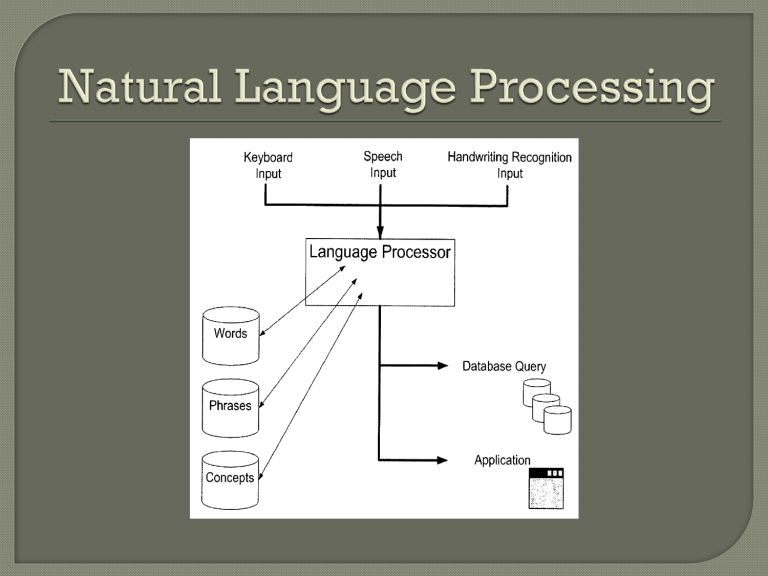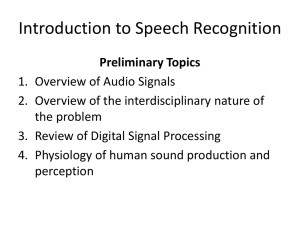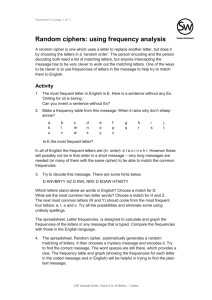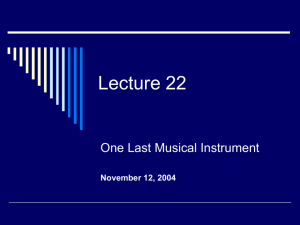Note
advertisement

Signal Processing: Spectral analysis. Physics (Acoustics): Study of Sound Pattern Recognition: Data Clustering Information Theory: Statistical Models Linguistics: Grammar and Language Structures • Morphology: Language structure • Phonology: Classification of linguistic sounds • Semantics: Study of meaning • Pragmatics: How language is used Physiology: Human Speech Production and Perception Computer Science: Devise Efficient Algorithms Note: Understanding of human speech recognition is rudimentary Phone and tablet applications Dictation Real time vocal tract visualization Speaker identification and/or verification Language translation Robot interaction Expert systems Audio databases Personal assistant Audio device command and control Long-term benefit after the novelty wears off Intuitive and easy to use Easy recovery in presence of mistakes • Self-correction algorithms when possible • Verification before proceeding • Automatic transfer to human operator • Backup mode of communication (spell the command) Accuracy of 95% or better in less than optimal environments Real time response (250 MS or less) Language dependent or independent • • • • Consistently achieving 95% accuracy or better • • • • • Grammatical models (context, semantics, idioms) Number of languages supported Assessing meaning to words not in the dictionary Available language-based resources Speech enhancement algorithms Filtering background noise and transmission distortions Voice activity detection Detect boundaries between speech segments Handling the slurring of words and co-articulation Training requirements Mode of speaking Speaker set Environment Vocabulary Isolated word Speaker Dependent noise free small (<50) Connect-word Multi-speaker office medium (<500) Continuous Independent telephone large (<5000) high noise very large (>5000) SPEECH WHY HARD? • A time-varying signal • Speaker variations; accents • Well-structured process • Changes in speed, loudness, and pitch • Limited, known physical movements • Environmental noise • 40-60 distinct units • Slurred, bad grammar (phonemes) per language • Enhanced to overcome noise should be easy!?? • Fuzzy phoneme boundaries • Context-based semantics • Large vocabulary • Signal redundancies 8 As easy on the mouth as possible to still be understood What is this English sentence? “ay d ih s h er d s ah m th in ng ah b aw ya m uh v ih ng r ih s en l ih” Where are the word boundaries? The speech is slurred with grammar errors Recognition is possible because: • We are sure of the phonetic components • We know the language (English) 99% accuracy Robo: “Hi, my name is Robo. I am looking for work to raise funds for Natural Language Processing research.” Person: “Do you know how to paint?” Robo: “I have successfully completed training in this skill.” Person: “Great! The porch needs painting. Here are the brushes and paint.” Robot rolls away efficiently. An hour later he returns. Robo: “The task is complete.” Person: “That was fast, here is your salary; good job, and come back again.” Robo speaks while rolling away with the payment. Robo: “The car was not a Porche; it was a Mercedes.” I cooked waterfowl for her. I stole her waterfowl and cooked it. I created a living waterfowl for her. I caused her to bid low in the game of bridge. I created the plastic duck that she owns. I caused her to quickly lower her head or body. I waved my magic wand and turned her into waterfowl. • I caused her to avoid the test. • • • • • • • I cdnuolt blveiee that I cluod aulaclty uesdnatnrd what I was rdgnieg. The phaonmneal pweor of the hmuan mnid Aoccdrnig to rscheearch at Cmabridgde Uinervtisy, it deosn't mttaer in what oredr the ltteers in a word are, the olny iprmoatnt tihng is that the frist and lsat ltteer be in the rghit pclae. The rset can be a taotl mses and you can still raed it wouthit a problem. This is bcuseae the huamn mnid deos not raed ervey lteter by istlef, but the word as a wlohe. Amzanig huh? Yaeh and I awlyas thought slpeling was ipmorantt! Phoneme: Smallest discrete unit of sound that distinguishes words (Minimal Pair Principle) Syllable: Acoustic component perceived as a single unit Morpheme: Smallest linguistic unit with meaning Word: Speaker identifiable unit of meaning Phrase: Sub-message of one or more words Sentence: Self-contained message derived from a sequence of phrases and words Phones: Set of all possible sounds that humans can articulate. Each language selects a set of phonemes from the larger set of phones (English ≈ 40). Our hearing is tuned to respond to this smaller set. Speech is a highly redundant sequential signal containing a sequence of sounds (phonemes) , pitch (prosody), gestures, and other expressions that vary with time. A complex wave of varying atmospheric pressure traveling through space The pressure is measured (sampled) at regular intervals to produce a digital array of amplitudes Speech frequencies of interest are 100 to 3400 samples per second The Nyquist theorem requires measurements of at least double the frequencies of interest The sample rate must be at least twice the rate of the highest frequency of interest Sampling at 1.5 times per cycle Original Continuous Analog Signal • Virtually contains an infinite number of frequencies Sampling Rates (Measurements per second) • Mac: 44,100 2-byte samples per second (705kbps) • PC: 16,000 2-byte samples per second (256kbps) • Telephone: 8k 1-byte sample per second (64kbps) Compression for communication • Code Excited Linear Prediction Compression: 8kbps • Research: 4kbps, 2.4 kbps • Military applications: 600 bps • Human brain: 50 bps Speech Signal Speech Recognition Words “How are you?” Goal: Automatically extract the string of words spoken from the speech signal LML Speech Recognition 2008 18 Acoustic Speech Signal Perception LML Speech Recognition 2008 Production 19 ACORNS Sound Editor is Downloadable (ACORNS web-site) Time Domain: 8k – 44.1k Samples per second Top: “this is a demo” Bottom: “A goat …. A coat” Time Domain: Signal is a composite wave of different frequencies Frequency Domain: Split time domain into the individual frequencies Fourier: We can compute the phase and amplitude of each composite sinusoid FFT: An efficient algorithm to perform the decomposition Sine waves combine to form a new wave of a different shape Every complex wave pattern consists of a series of composite sine waves All of the composite sine are multiples of a basic frequency Speech mostly consists of sinusoids combined together by linear addition Audio: “This is a Demo” Narrow band: Shows harmonics – horizontal lines Harmonic definition: Integral multiple of a basic frequency Wide Band: Shows pitch – pitch periods are vertical lines Horizontal = time, vertical = frequency, frequency amplitude = darkness Acoustic Speech Signal Speech Recognition Words “How are you?” Input Speech Acoustic Front-end Acoustic Models P(A|W) Language Model P(W) Search Recognized Utterance LML Speech Recognition 2008 Processing Language Model 24 Note: Velum (soft palate) position controls nasal sounds, epiglottis closes when swallowing Speaker alters vocal tension of the vocal folds • Opened folds, speech is unvoiced resembling noise • If folds are stretched close, speech is voiced Air pressure builds and vocal folds blow open releasing pressure and elasticity causes the vocal folds to fall back Average fundamental frequency (F0): 60 Hz to 300 Hz Speakers control vocal tension to alter F0 and the perceived pitch Closed Period Open Falsetto – The vocal cords are stretched and become thin causing high frequency Creaky – Only the front vocal folds vibrate, giving a low frequency Breathy – Vocal cords vibrate, but air is escaping through the glottis Each person tends to consistently use particular phonation patterns. This makes the voice uniquely theirs Articulation: Shaping the speech sounds Bilabial – The two lips (p, b, and m) Labio-dental – Lower lip and the upper teeth (v) Dental – Upper teeth and tongue tip or blade (thing) Alveolar –Alveolar ridge + tongue tip or blade (d, n, s) Post alveolar –Area just behind the alveolar ridge and tongue tip or blade (jug ʤ, ship ʃ, chip ʧ, vision ʒ) Retroflex – Tongue curled and back (rolling r) Palatal – Tongue body touches the hard palate (j) Velar – Tongue body touches soft palate (k, g, ŋ (thing)) Glottal – larynx (uh-uh, voiced h) Voiced: The vocal cords are vibrating, Unvoiced: vocal cords don’t vibrate Obstruent: Frequency domain is similar to noise • Fricative: Air flow not completely shut off • Affricate: A sequence of a stop followed by a fricative • Sibilant: a consonant characterized by a hissing sound (like s or sh) Trill: A rapid vibration of one speech organ against another (Spanish r). Aspiration: burst of air following a stop. Stop: Air flow is cut off • Ejective: airstream and the glottis are closed and suddenly released (/p/). • Plosive: Voiced stop followed by sudden release • Flap: A single, quick touch of the tongue (t in water). Nasality: Lowering the soft palate allows air to flow through the nose Glides: vowel-like, syllable position makes them short without stress (w, y). An On-glide is a glide before a vowel; an off-glide is a glide after vowel Approximant (semi-vowels): Active articulator approaches the passive articulator, but doesn’t totally shut of (L and R). Lateral: The air flow proceeds around the side of the tongue No restriction of the vocal tract, articulators alter the formants Diphthong: Syllabics which show a marked glide from one vowel to another, usually a steady vowel plus a glide Nasalized: Some air flow through the nasal cavity Rounding: Shape of the lips Tense: Sound more extreme (further from the schwa) and tend to have the tongue body higher Relaxed: Sounds closer to schwa (tonally neutral) Tongue position: Front to back, high to low Schwa: unstressed central vowel (“ah”) Significant obstruction in the nasal or oral cavities Occur in pairs or triplets and can be voiced or unvoiced Sonorant: continuous voicing Unvoiced: less energy Plosive: Period of silence and then sudden energy burst Lateral, semi vowels, retroflex: partial air flow block Fricatives, affricatives: Turbulence in the wave form Type Phones Mechanism Plosive b,p,d,t,g,k Close oral cavity Nasal m, n, ng Open nasal cavity Fricative v,f,z,s,dh,th,zh, sh Turbulent Affricate jh, ch Stop + Turbulent Retroflex Liquid r Tongue high and curled Lateral liquid l Side airstreams Glide w, y Vowel like Labial Labio- Dental dental Aveolar Plosive pb td kg Nasal m n ng Fricative f v th dh sz Retroflex sonorant r Lateral sonorant l Glide w Palatal Velar sh zh y Glottal ? h • • • • Devices used to measure speech production Plate attached to roof of mouth measuring contact Collar around the neck measuring glottis vibrations Measure air flow from mouth and nose Three dimension images using MRI Note: The International Phonetic Alphabet (IPA) was designed before the above technologies existed. They were devised by a linguist looking down someone’s mouth or feeling how sounds are made. Phone [iy] [ih] [eh] [ah] [x] [ao] [ow] [uh] [ey] [er] [ay] [oy] [arr] [aw] [ax] [ix] [aa] Example beat bit bet but bat bought boat book bait bert buy boy dinner down about roses cot Phone Example Phone [b] bet [ch] chet [r] [d] debt [s] [f] fat [sh] [g] get [hh] hat [th] [hy] high [dh] [jh] jet [dx] [k] kick [v] [l] let [w] [m] met [wh] [em] bottom [n] net [y] [en] button [z] [ng] sing [zh] [eng] washing [-] Example [p] pet rat set shoe [t] ten thick that butter vet wet which yet zoo measure silence A standard that attempts to create a notation for all possible human sounds Caution: American English tongue positions don’t exactly match the chart. For example, ‘father’ in English does not have the tongue position as far back as the IPA vowel chart shows. Phoneme Tree Categorization from Rabiner and Juang Characteristics: Vowels & Diphthongs Vowels • /aa/, /uw/, /eh/, etc. • Voiced speech • Average duration: 70 msec • Spectral slope: higher frequencies have lower energy (usually) • Resonant frequencies (formants) at well-defined locations • Formant frequencies determine the type of vowel Diphthongs • /ay/, /oy/, etc. • Combination of two vowels • Average duration: about 140 msec • Slow change in resonant frequencies from beginning to end Some perceptual components are understood, but knowledge concerning the entire human perception model is rudimentary Understood Components 1. The inner ear works as a bank of filters 2. Sounds are perceived logarithmically, not linearly 3. Some sounds will mask others Two sensory organs are located in the inner ear. • The vestibule is the organ of equilibrium • The cochlea is the organ of hearing Human hearing is sensitive to about 25 ranges of frequencies Cochlea transforms pressure variations to neural impulses Approximately 30,000 hair cells along basilar membrane Each hair cell has hairs that bend to basilar vibrations High-frequency detection is near the oval window. Low-frequency detection is at far end of the basilar membrane. Auditory nerve fibers are ``tuned'' to center frequencies. Note: Basilar Membrane shown unrolled Thin elastic fibers stretched across the cochlea • Short, narrow, stiff, and closely packed near the oval window • Long, wider, flexible, and sparse near the end of the cochlea • The membrane connects to a ligament at its end. Separates two liquid filled tubes that run along the cochlea • The fluids are very different chemically and carry the pressure waves • A leakage between the two tubes causes a hearing breakdown Provides a base for sensory hair cells • The hair cells above the resonating region fire more profusely • The fibers vibrate like the strings of a musical instrument. Decomposing the sound spectrum Georg von Bekesy’s Nobel Prize discovery • High frequencies excite the narrow, stiff part at the end • Low frequencies excite the wide, flexible part by the apex Auditory nerve input • Hair cells on the basilar membrane fire near the vibrations • The auditory nerve receives frequency coded neural signals • A large frequency range possible; basilar membrane’s stiffness is exponential Demo at: http://www.blackwellpublishing.com/matthews/ear.html The hair cells are in rows along the basilar membrane. Individual hair cells have multiple strands or stereocilia. • The sensitive hair cells have many tiny stereocilia which form a conical bundle in the resting state • Pressure variations cause the stereocilia to dance wildly and send electrical impulses to the brain. There is a voltage difference across the cell • The stereocilia projects into the endolymph fluid (+60mV) • The perylymph fluid surrounds the membrane of the haircells (-70mV) When the hair cells moves • The potential difference increases • The cells fire We don't perceive speech linearly Cochlea hair cell rows act as frequency filters The frequency filters overlap From early place theory experiments Sound dB TOH 0 Whisper 10 Quiet Room 20 Office 50 Normal conversation 60 Busy street 70 Heavy truck traffic 90 Power tools 110 Pain threshold 120 Sonic boom 140 Permanent damage 150 Jet engine 160 Cannon muzzle 220 The hearing threshold varies at different frequencies Empirical formula to approximate the SPL threshold: SPL(f) = 3.65(f/1000)-0.8-6.5e-0.6(f/1000-3.3)^2+10-3(f/1000)4 Hearing threshold for men (M) and women (W) ages 20 through 60 MAF = Minimum Audio Frequency Note: The lines indicate the perceived DB relative to SPL for various frequencies A sound masks another sound that we can normally hear Frequency Masking (sounds close in frequency) The temporal masking (sounds close in time) • a sound masked by a nearby frequency. • Lossy sound compression algorithms makes use of this • Strong sound masks a weaker sound with similar frequency • Masking amount depends on the time difference • Forward Masking (earlier sound masks a later sound) • Backward Masking (later sound masks an earlier one) Noise Masking (noise has random frequency range) • Noise masks all frequencies. • All speech frequencies must be increased to decipher • Filtering of noise is required for speech recognition Noise will mask a tone if: • The noise is sufficiently loud • The time difference is short • Greater intensity increases masking time There are two types of masking • Forward: Noise masking a tone that follows • Backward: A tone is masked by noise that follows Delays • beyond 100 − 200 ms no forward masking occurs • Beyond 20 ms, no backward masking occurs. Training can reduce or eliminate the perceived backward masking Experiment 1. Fix one sound at a frequency and intensity 2. Vary a second sine wave’s intensity 3. Measure when the second sound is heard From CMU Robust Speech Group A narrow band of noise at 410 Hz Analyze audio according to human hearing sensitivity Mel scale: f Mel( f ) 2595 log 10 (1 ) 700 Bark scale: Bark( f ) 26.81 f 0.53 1960 f Formulas to convert linear frequencies to MEL and BARK frequencies Apply an algorithm to mimic the overlapping cochlea rows of hair cells 1. 2. 3. 4. 5. 6. Apply the MEL formula to warp the frequencies from the linear to the MEL scale Triangle peaks are evenly spaced through the MEL scale for however number of MEL filters desired Start point of one triangle is the middle of the previous End point to middle equals start point to middle Sphinx speech recognizer: Height is 2/(size of un-scaled base) Perform weighted sum to fill up filter bank array 2.5 2 Blue: Bark 1.5 Perceptual scale Scale Red: Mel Scale Green: ERB Scale 1 0.5 0 -0.5 -1 0 500 1000 1500 2000 2500 3000 Frequency, Hz 3500 Equivalent Rectangular Bandwidth (ERB) is an unrealistic but simple rectangular approximation to model the filters in the cochlea 4000 4500 5000 F0: Vocal cord vibration frequency (pitch) • Averages: Male = 100 Hz, Female = 200 Hz, Children = 300 Hz F1, F2, F3: Fundamental frequency harmonics • Varies depending on vocal tract shape and length • Articulators to the back brings formants together • Articulators to the front moves formants apart • Roundness impacts the relationship between F2 and F3 • Spreads out as the pitch increases • Adds timbre (quality other than pitch or intensity) to voiced sounds Advantage: Excellent feature for distinguishing vowels Disadvantage: Not able to distinguishing unvoiced sounds “a” from “this is a demo” Note: The vocal fold vibration is somewhat noisy, (a combination of frequencies) Peterson and Barney recorded 76 speakers at the 1939 World’s Fair in New York City, and published their measurements of the vowel space in 1952. Demo: http://faculty.washington.edu/dillon/PhonResources/vowels.html Vowel Word high Low front back round tense F1 F2 Iy Feel + - + - - + 300 2300 Ih Fill + - + - - - 360 2100 ae Gas - + + - - + 750 1750 aa Father - + - - - + 680 ah Cut - - - - - + 720 1240 ao Dpg - - - - - - 600 ax Comply - - + - - - 720 1240 eh Pet - - - + + + 570 1970 ow Tone + - - + - - 600 900 uh Good + - - + - + 380 950 uw Tool 300 940 1100 900 e eh ae o u ih uh ah a w Frequency Domain: Vowels & Diphthongs /ah/: low, back /iy/: high, front /ay/: diphthong Frequency Domain: Nasals Nasals • /m/, /n/, /ng/ • Voiced speech • Spectral slope: higher frequencies have lower energy (usually) • Spectral anti-resonances (zeros) • Resonances and anti-resonances often close in frequency. Frequency Domain: Fricatives Fricatives • /s/, /z/, /f/, /v/, etc. • Voiced and unvoiced speech (/z/ vs. /s/) • Resonant frequencies not as well modeled as with vowels Frequency Domain: Plosives (Stops) & Affricates Plosives • /p/, /t/, /k/, /b/, /d/, /g/ • Sequence of events: silence, burst, frication, aspiration • Average duration: about 40 msec (5 to 120 msec) Affricates • /ch/, /jh/ • Plosive followed immediately by fricative





